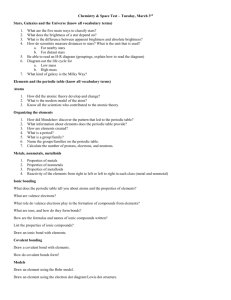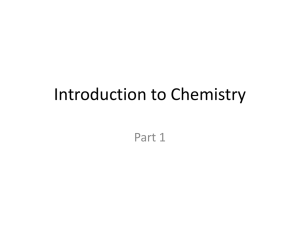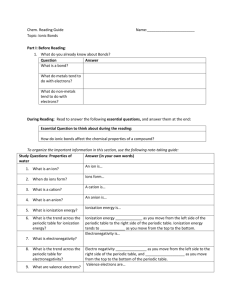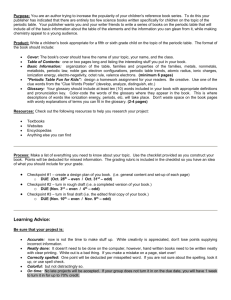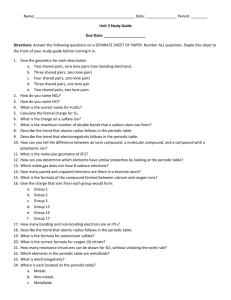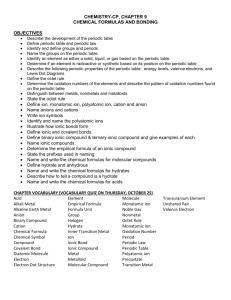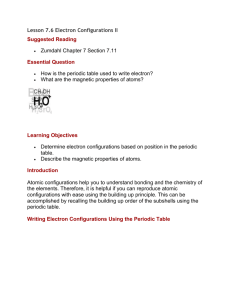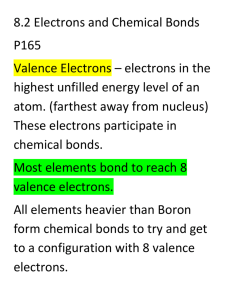final study guide help
advertisement
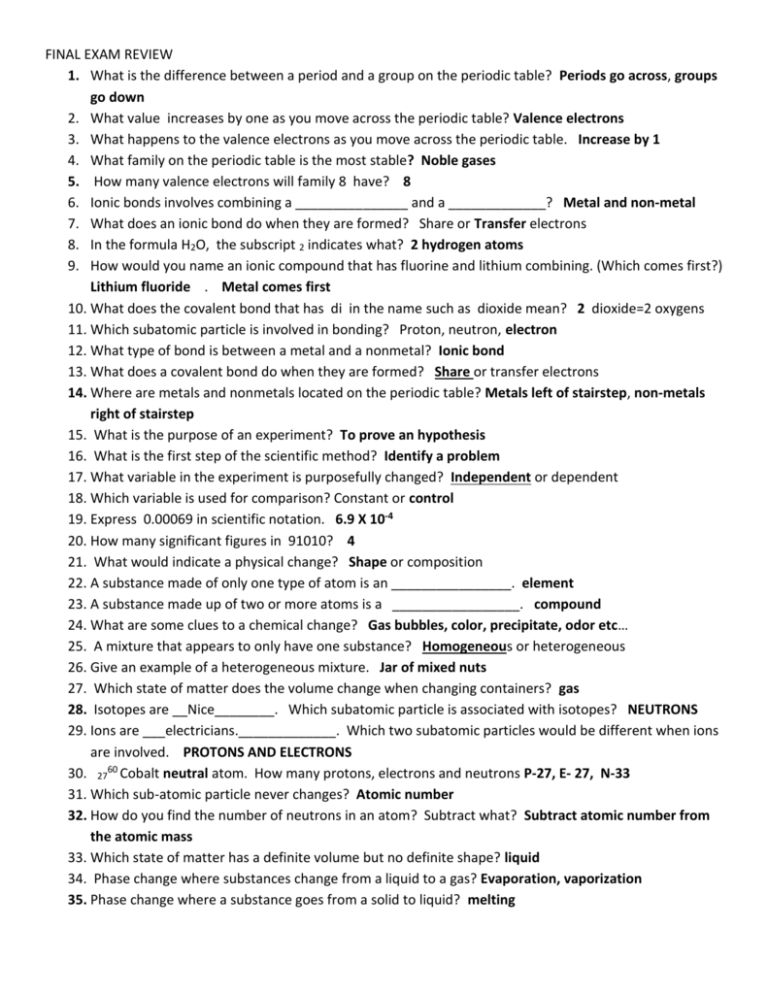
FINAL EXAM REVIEW 1. What is the difference between a period and a group on the periodic table? Periods go across, groups go down 2. What value increases by one as you move across the periodic table? Valence electrons 3. What happens to the valence electrons as you move across the periodic table. Increase by 1 4. What family on the periodic table is the most stable? Noble gases 5. How many valence electrons will family 8 have? 8 6. Ionic bonds involves combining a _______________ and a _____________? Metal and non-metal 7. What does an ionic bond do when they are formed? Share or Transfer electrons 8. In the formula H2O, the subscript 2 indicates what? 2 hydrogen atoms 9. How would you name an ionic compound that has fluorine and lithium combining. (Which comes first?) Lithium fluoride . Metal comes first 10. What does the covalent bond that has di in the name such as dioxide mean? 2 dioxide=2 oxygens 11. Which subatomic particle is involved in bonding? Proton, neutron, electron 12. What type of bond is between a metal and a nonmetal? Ionic bond 13. What does a covalent bond do when they are formed? Share or transfer electrons 14. Where are metals and nonmetals located on the periodic table? Metals left of stairstep, non-metals right of stairstep 15. What is the purpose of an experiment? To prove an hypothesis 16. What is the first step of the scientific method? Identify a problem 17. What variable in the experiment is purposefully changed? Independent or dependent 18. Which variable is used for comparison? Constant or control 19. Express 0.00069 in scientific notation. 6.9 X 10-4 20. How many significant figures in 91010? 4 21. What would indicate a physical change? Shape or composition 22. A substance made of only one type of atom is an ________________. element 23. A substance made up of two or more atoms is a _________________. compound 24. What are some clues to a chemical change? Gas bubbles, color, precipitate, odor etc… 25. A mixture that appears to only have one substance? Homogeneous or heterogeneous 26. Give an example of a heterogeneous mixture. Jar of mixed nuts 27. Which state of matter does the volume change when changing containers? gas 28. Isotopes are __Nice________. Which subatomic particle is associated with isotopes? NEUTRONS 29. Ions are ___electricians._____________. Which two subatomic particles would be different when ions are involved. PROTONS AND ELECTRONS 30. 2760 Cobalt neutral atom. How many protons, electrons and neutrons P-27, E- 27, N-33 31. Which sub-atomic particle never changes? Atomic number 32. How do you find the number of neutrons in an atom? Subtract what? Subtract atomic number from the atomic mass 33. Which state of matter has a definite volume but no definite shape? liquid 34. Phase change where substances change from a liquid to a gas? Evaporation, vaporization 35. Phase change where a substance goes from a solid to liquid? melting 36. What is the difference between a physical property and a chemical property? Chemical property changes the composition while a physical property does NOT change the composition but describes characteristics of the substance. 37. What happens to the temperature during a phase change? STAYS THE SAME 38. Conservations of matter says: _MATTER_cannot be created or DESTROYED, only change __FORMS__ therefore the energy has been ___CONSERVED_ 39. Which substances undergo change in a chemical reaction? Reactants or products CH4 + 2O2 2H2O + CO2 or CH4 + O H2O + CO2 40. Which of the following is balanced? 41. Give an example of a synthesis reaction. (Use A, B, C, and D) A + B = AB 42. Give an example of a single-replacement reaction. (Use A, B, C, and D) A+BC-> AC+B 43. Give an example of a decomposition reaction. (use A, B, C and D) AB A+ B 44. What happens to the reaction rate if the temperature is increased? Increases 45. What does the arrow mean in an equation? Yields/produces 46. A catalyst (increases/decreases) a reaction (by/without) changing the products. 47. What is the 2 in the formula H2O considered? Coefficient or subscript 48. How many oxygens are in the following formula 4Ca(NO3)2. Don’t forget the Coefficient and parenthesis. 24 49. What are the numbers on the pH scale. From _____ to _____. 0-14 50. Which numbers on the pH scale are most acidic? 0-6.9 51. How do you neutralize an acid? Add a base 52. What type of reaction is A + BC -> B + AC single-replacement 53. All the species that live in one area are called? population 54. What is a model that shows the complex relationships in a community? Food WEB 55. What is the difference between a biotic factor and an abiotic factor? Biotic are living and abiotic – nonliving and never lived 56. What is the difference between a predator and prey? Predator searches and catches prey 57. A symbiotic relationship where both species benefit is ? mutualism, commensalism, parasitism 58. What happens to a population if the resources decrease? Decline 59. What are limiting factors? Factors that cause a community or species to decline such as competition, predation, human interference 60. What happens when the population is higher than the carrying capacity? Death rate will rise 61. What are the 3 types of rocks? Igneous, metamorphic, sedimentary 62. What is a fault? Fracture in earth’s crust 63. Where is the epicenter located in relation to the focus? Epicenter on surface of earth on top of focus 64. What is the name of the theory that explains the cause of earthquakes? Elastic rebound 65. What’s the most destructive seismic wave? Surface waves 66. What is the outer layer of the earth called? crust 67. Which plate boundary doesn’t build up or destroy the land? transform 68. Which plate boundaries move together? convergent 69. What type of plate boundary is where new crust is formed? divergent 70. What type of volcano is from ejected lava fragments? Cinder cone 71. Which volcano is broad and dome shaped? shield 72. Which volcano has both lave and pyroclastic deposits? composite 73. How do we measure seismic waves? seismograph 74. What is the source of an earthquake called? FOCUS 75. What is the fastest seismic wave? P waves 76. What type of plate boundaries is the lithosphere destroyed? convergent


